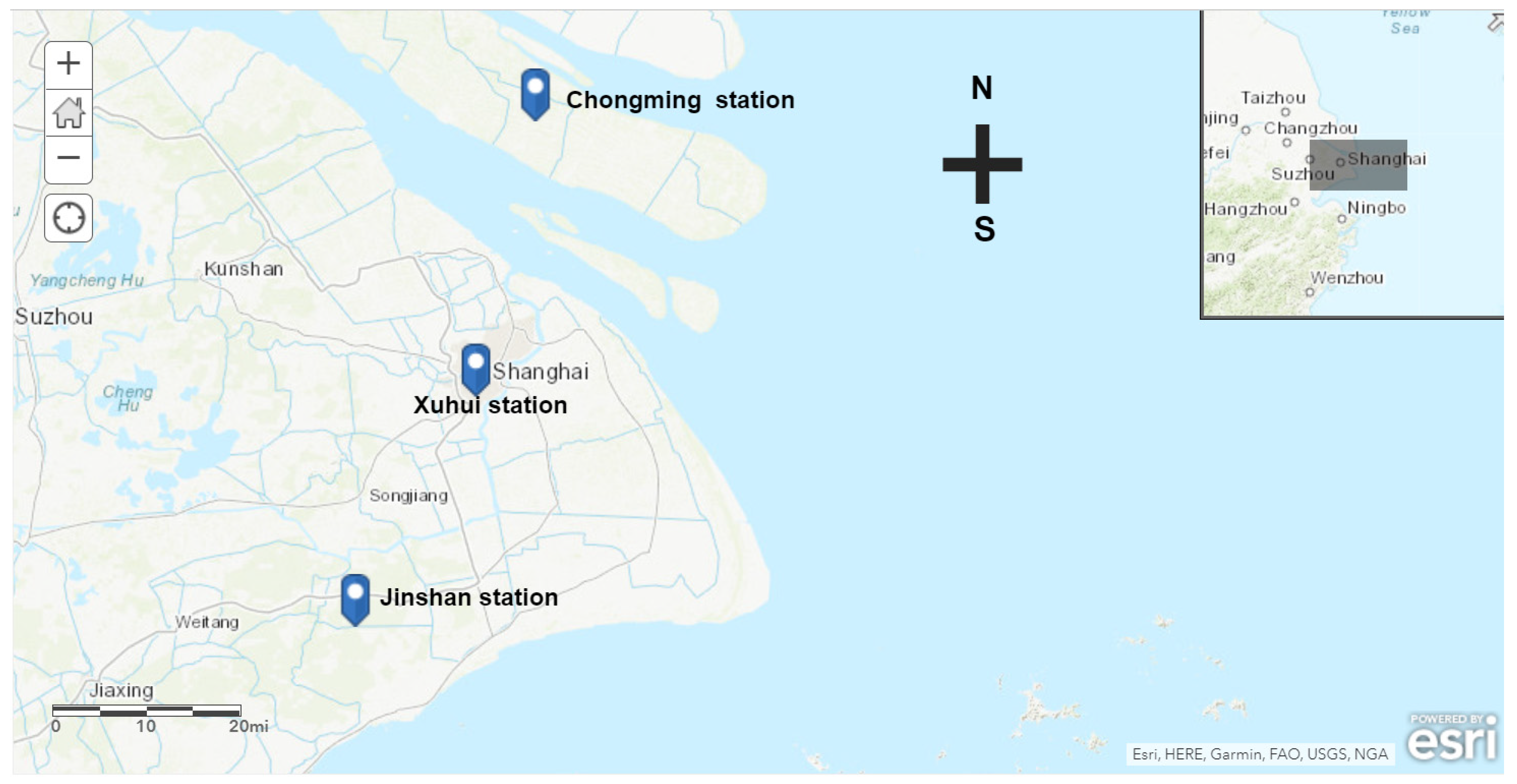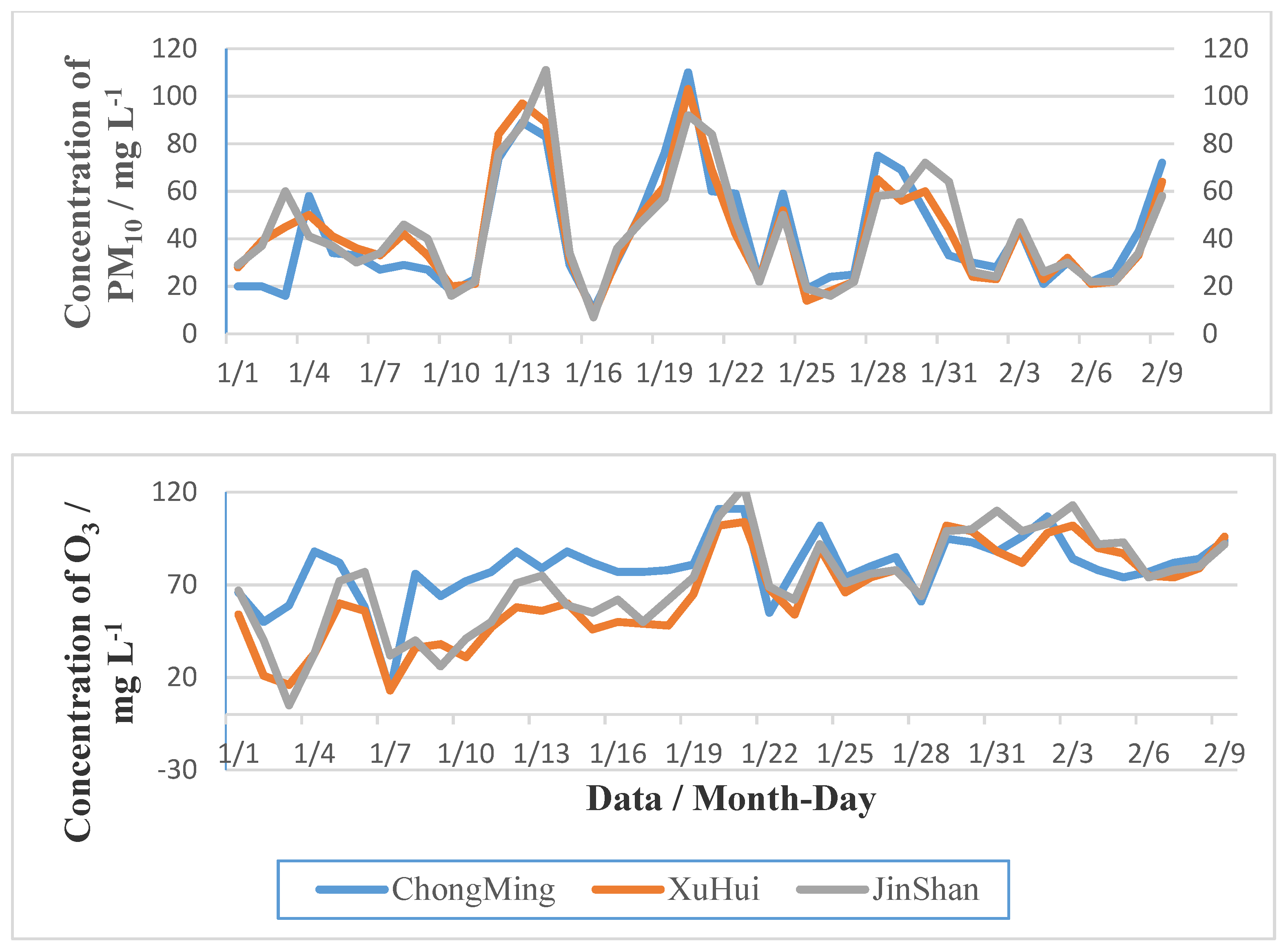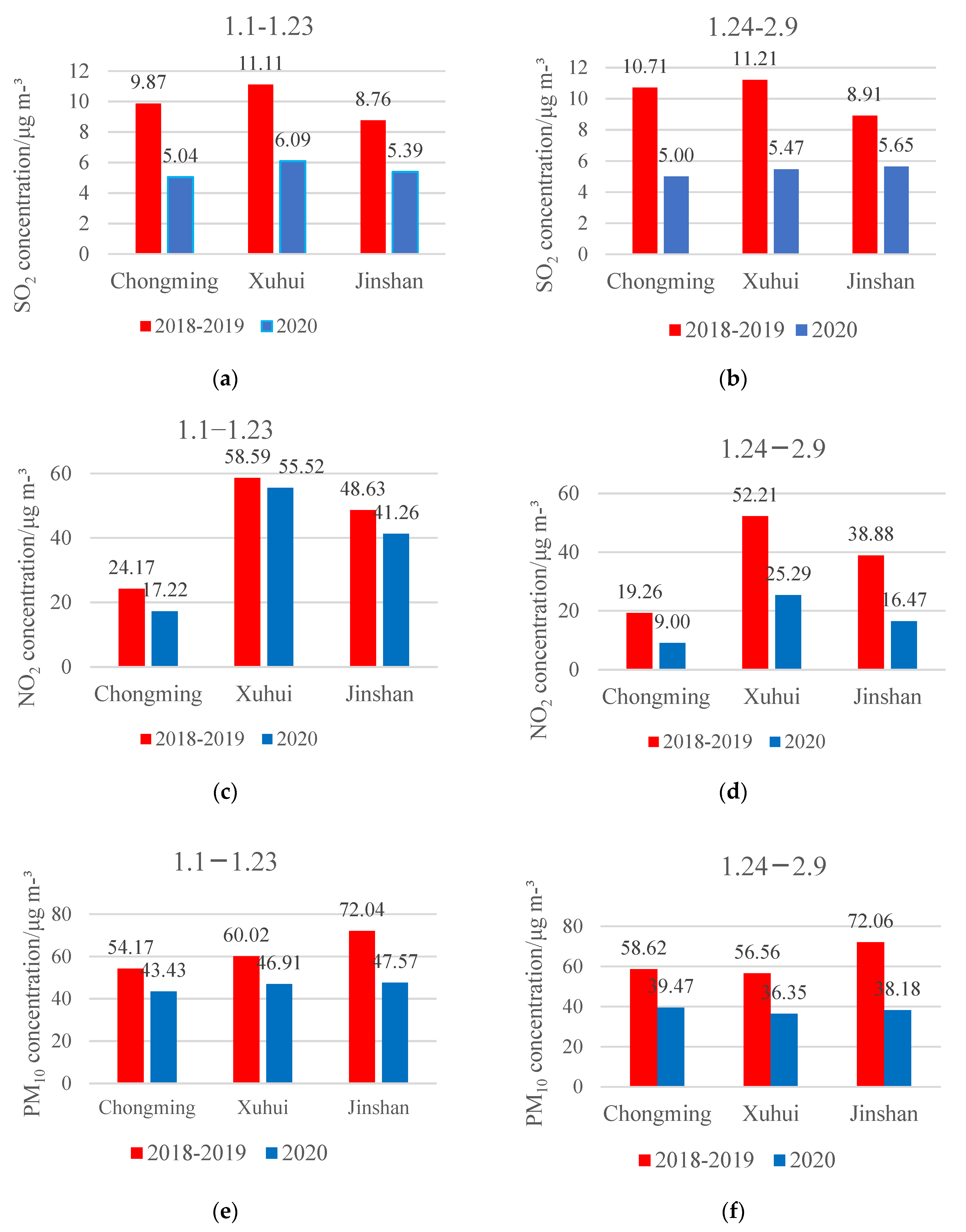Reflections Based on Pollution Changes Brought by COVID-19 Lockdown in Shanghai
Abstract
:1. Introduction
2. Methods
2.1. Data Collection
2.2. Data Processing
3. Results
3.1. Major Pollutants in Different Areas of Shanghai during COVID-19 in Year 2020
3.2. Comparison of Major Pollutants in Different Functional Areas
3.3. Comparison of Major Pollutants on the Same Days from Different Years
4. Discussion
4.1. Major Pollutants in Different Functional Areas Duiring COVID-19
4.2. Availability of Lockdown Policy’s Response to the Diffusion of COVID-19
4.3. Implication of Environment Policies Taken by China
4.4. Other Positive Effects Brought by the Lockdown Policy
5. Conclusions
Supplementary Materials
Author Contributions
Funding
Institutional Review Board Statement
Informed Consent Statement
Data Availability Statement
Acknowledgments
Conflicts of Interest
References
- Real-Time Epidemic Tracking Analysis of COVID-19. Available online: https://www.360kuai.com/mob/subject/400 (accessed on 15 September 2021).
- Xu, Z.; Shi, L.; Wang, Y.; Zhang, J.; Huang, L.; Zhang, C.; Liu, S.; Zhao, P.; Liu, H.; Zhu, L.; et al. Pathological findings of COVID-19 associated with acute respiratory distress syndrome. Lancet Respir. Med. 2020, 8, 420–422. [Google Scholar] [CrossRef]
- Xinhua. COVID-19 Delta Variant Spreading Worldwide “at Scorching Pace”: WHO Chief. Available online: http://www.xinhuanet.com/english/2021-07/13/c_1310057228.htm (accessed on 13 July 2021).
- Xinhua. COVID-19 Delta Variant Infections Account for 20 Pct of New Cases in France. Available online: http://www.xinhuanet.com/english/2021-06/29/c_1310034461.htm (accessed on 29 June 2021).
- East English. What You Need to Know about the COVID-19 Delta Variant. Available online: https://baijiahao.baidu.com/s?id=1707085898392734558 (accessed on 3 August 2021).
- Haug, N.; Geyrhofer, L.; Londei, A.D.; Larrive, A.; Loreto, V.; Pinior, B. Ranking the effectiveness of worldwide COVID-19 government interventions. Nat. Hum. Behav. 2020, 4, 1303–1312. [Google Scholar] [CrossRef]
- Chinese Centre for Disease Control and Prevention. Available online: http://www.chinacdc.cn/en/2020 (accessed on 12 February 2020).
- Shanghai Implements “the Strictest Scientific Prevention and Control Measures” after Launching a First-Level Response Mechanism. Available online: https://tech.sina.com.cn/roll/2020-01-25/doc-iihnzhha4640599.shtml (accessed on 23 January 2020).
- Wang, Q.; Su, M. A preliminary assessment of the impact of COVID-19 on environment—A case study of China. Sci. Total Environ. 2020, 728, 138915. [Google Scholar] [CrossRef] [PubMed]
- Wu, C.-L.; Wang, H.-W.; Cai, W.-J.; He, H.-D.; Ni, A.-N.; Peng, Z.-R. Impact of the COVID-19 lockdown on roadside traffic-related air pollution in Shanghai, China. Build. Environ. 2021, 194, 107718. [Google Scholar] [CrossRef] [PubMed]
- Wang, Y.; Yuan, Y.; Wang, Q.; Liu, C.; Zhi, Q.; Cao, J. Changes in air quality related to the control of coronavirus in China: Implications for traffic and industrial emissions. Sci. Total. Environ. 2020, 731, 139133. [Google Scholar] [CrossRef] [PubMed]
- Shanghai Municipal Bureau of Ecology and Environment. Joint Operation of Accelerating the Measures of Air Pollution Containment. Available online: https://sthj.sh.gov.cn/ (accessed on 12 February 2020).
- PM2.5 and PM10, You May Hear a Lot! What Are They Actually? Available online: https://www.sohu.com/a/290591956_120029446 (accessed on 21 January 2019).
- Sicard, P.; Marco, A.; Agthokleous, E.; Feng, Z.Z.; Xu, X.; Paoletti, E. Amplified ozone pollution in cities during the COVID-19 lockdown. Sci. Total Environ. 2020, 735, 139542. [Google Scholar] [CrossRef]
- Su, S. Sulphur Dioxide Emissions from Combustion in China: From 1990. Available online: https://pubs.acs.org/doi/10.1021/es201656f (accessed on 18 August 2011).
- Wang, L.; Zhao, X.; Xu, W.; Tang, J.; Jiang, X. Correlation analysis of lung cancer and urban spatial factor: Based Correlation analysis of lung cancer and urban spatial factor: Based on survey in Shanghai. J. Thorac. Dis. 2016, 8, 9373. [Google Scholar] [CrossRef] [PubMed] [Green Version]
- Wang, T.; Xue, L.; Brimblecombe, P.; Lam, Y.F.; Li, L.; Zhang, L. Ozone pollution in China: A review of concentrations, meteorological influences, chemical precursors, and effects. Sci. Total Environ. 2017, 575, 1582–1596. [Google Scholar] [CrossRef] [PubMed]
- Xie, J.; Teng, J.; Fan, Y.; Xie, R.; Shen, A. The short-term effects of air pollutants on hospitalizations for respiratory disease in Hefei, China. Int. J. Biometeorol. 2019, 63, 315–326. [Google Scholar] [CrossRef] [PubMed]
- Chen, Z.; Cai, J.; Gao, B.; Xu, B.; Dai, S.; He, B.; Xie, X. Detecting the causality influence of individual meteorological factors on local PM2.5 concentration in the Jing-Jin-Ji region. Sci. Rep. 2017, 7, 40735. [Google Scholar] [CrossRef] [PubMed] [Green Version]
- Zhou, Y.; Zhang, Y.; Ma, D.; Lu, J.; Luo, W.; Fu, Y.; Li, S.; Feng, J.; Huang, C.; Ge, W.; et al. Port-Related Emissions, Environmental Impacts and Their Implication on Green Traffic Policy in Shanghai. Sustainability 2020, 12, 4162. [Google Scholar] [CrossRef]
- Zhang, J. Transport policymaking that accounts for COVID-19 and future public health threats: A PASS approach. Transp. Policy 2020, 99, 405–418. [Google Scholar] [CrossRef] [PubMed]
- Nam, K.-M.; Zhang, X.; Zhong, M.; Saikawa, E.; Zhang, X. Health effects of ozone and particulate matter pollution in China: A province-level CGE analysis. Ann. Reg. Sci. 2019, 63, 269–293. [Google Scholar] [CrossRef]
- Ma, J.; Chen, Z.; Wu, M.; Feng, J.; Horii, Y.; Ohura, T.; Kannan, K. Airborne PM2.5/PM10-Associated Chlorinated Polycyclic Aromatic Hydrocarbons and their Parent Compounds in a Suburban Area in Shanghai, China. Environ. Sci. Technol. 2013, 47, 7615–7623. [Google Scholar] [CrossRef] [PubMed]
- Zeng, P.; Lyu, X.; Guo, H.; Cheng, H.; Jiang, F.; Pan, W.; Wang, Z.; Liang, S.; Hu, Y. Causes of ozone pollution in summer in Wuhan, Central China. Environ. Pollut. 2018, 241, 852–861. [Google Scholar] [CrossRef] [PubMed]
- An, X.; Hou, Q.; Li, N.; Zhai, S. Assessment of human exposure level to PM10 in China. Atmos. Environ. 2013, 70, 376–386. [Google Scholar] [CrossRef]
- Becker, S.; Soukup, J.M. Exposure to urban air particulates alters the macrophage mediated inflammatory response to respiratory viral infection. J. Toxic Environ. Health 1999, 57, 445–457. [Google Scholar]
- Seo, J.H.; Kim, S.J.; Lee, M.; Kang, J.I. Impact of the COVID-19 pandemic on mental health service use among psychiatric outpatients in a tertiary hospital. J. Affect. Disord. 2021, 290, 279–283. [Google Scholar] [CrossRef]
- Cai, Q.-C.; Lu, J.; Xu, Q.-F.; Guo, Q.; Xu, D.-Z.; Sun, Q.-W.; Yang, H.; Zhao, G.-M.; Jiang, Q.-W. Influence of meteorological factors and air pollution on the outbreak of severe acute respiratory syndrome. Public Healh 2007, 121, 258–265. [Google Scholar] [CrossRef]
- Horne, B.D.; Joy, E.A.; Hofmann, M.G.; Gesteland, P.H.; Cannon, J.B.; Lefler, J.; Blagev, D.P.; Korgenski, E.K.; Torosyan, N.; Hansen, G.I.; et al. Short-Term Elevation of Fine Particulate Matter Air Pollution and Acute Lower Respiratory Infection. Am. J. Respir. Crit. Care Med. 2018, 198, 759–766. [Google Scholar] [CrossRef]
- Gao, W.; Tie, X.; Xu, J.; Huang, R.-J.; Mao, X.; Zhou, G.; Chang, L. Long-term trend of O3 in a mega City (Shanghai), China: Characteristics, causes, and interactions with precursors. Sci. Total Environ. 2017, 603–604, 425–433. [Google Scholar] [CrossRef] [PubMed]
- Bray, C.D.; Nahas, A.; Battye, W.H.; Aneja, V.P. Impact of Lockdown during the COVID-19 Outbreak on Multi-Scale Air Quality. Atmos. Environ. 2021, 254, 118386. [Google Scholar] [CrossRef] [PubMed]
- Geng, F.H.; Zhao, C.S.; Tang, X.; Lu, G.L.; Tie, X. Analysis of ozone and VOCsmeasured in Shanghai: A case study. Atmos. Environ. 2007, 41, 989–1001. [Google Scholar] [CrossRef]
- Shi, X.; Brasseur, G.P. The Response in Air Quality to the Reduction of Chinese Economic Activities During the COVID-19 Outbreak. Geophys. Res. Lett. 2020, 47, e2020GL088070. [Google Scholar] [CrossRef]
- He, G.; Pan, Y.; Tanaka, T. The short-term impacts of COVID-19 lockdown on urban air pollution in China. Nat. Sustain. 2020, 3, 1005–1011. [Google Scholar] [CrossRef]
- Pg, A.; Sc, B.; Aa, D.; Pdh, C.; Wh, B.; Pc, A. Short-term and long-term health impacts of air pollution reductions from covid-19 lockdowns in china and europe: A modelling study. Lancet Planet. Health 2020, 4, e474–e482. [Google Scholar]
- Zhang, D.; Li, H.; Zhu, H.; Zhang, H.; Goh, H.H.; Wong, M.C.; Wu, T. Impact of COVID-19 on Urban Energy Consumption of Commercial Tourism City. Sustain. Cities Soc. 2021, 73, 103133. [Google Scholar] [CrossRef]
- Chen, Q.; Pan, S. Transport-related experiences in China in response to the Coronavirus (COVID-19). Transp. Res. Interdiscip. Perspect. 2020, 8, 100246. [Google Scholar] [CrossRef]
- Copat, C.; Cristaldi, A.; Fiore, M.; Grasso, A.; Zuccarello, P.; Signorelli, S.S.; Conti, G.O.; Ferrante, M. The role of air pollution (PM and NO2) in COVID-19 spread and lethality: A systematic review. Environ. Res. 2020, 191, 110129. [Google Scholar] [CrossRef]
- Esworthy, R. Air quality: EPA’s 2013 changes to the particulate matter (PM) standard. Congr. Res. Serv. 2013, 6, 5700. [Google Scholar]
- Chen, S.; Dai, J.; Hu, Q.; Chen, H.; Wang, Y.; Gao, J.; Zheng, P.; Fu, H. Public anxiety and its influencing factors in the initial outbreak of COVID-19. Fudan Univ. J. Med. Sci. 2020, 43, 385–391. [Google Scholar]
- Tan, P.-H.; Chou, C.; Chou, C.C.-K. Impact of urbanization on the air pollution “holiday effect” in Taiwan. Atmos. Environ. 2013, 70, 361–375. [Google Scholar] [CrossRef]
- Noxon, J.F. Stratospheric NO2 in the Antarctic winter. Geophys. Res. Lett. 1978, 5, 1021–1022. [Google Scholar] [CrossRef]
- Sillman, S. The relation between ozone, NOx and hydrocarbons in urban and polluted rural environments. Atmos. Environ. 1999, 33, 1821–1845. [Google Scholar] [CrossRef]
- Find Out the Origin of the Epidemic in Xiamen! Many Parts of Fujian Cancel Mid-Autumn Festival Holiday. Available online: https://www.163.com/dy/article/GKBH7IE0051794EG.html (accessed on 13 July 2021).
- Wu, J.T.; Leung, K.L.; Leung, M. Nowcasting and forecasting the potential domestic and international spread of the 2019-CoV outbreak originating in Wuhan, China: A modelling study. Lancet 2020, 395, 689–697. [Google Scholar] [CrossRef] [Green Version]
- Cheshmehzangi, A. Reflection on early lessons for urban resilience and public health enhancement during the covid-19. Health 2020, 12, 1390–1408. [Google Scholar] [CrossRef]
- Wyche, K.; Nichols, M.; Parfitt, H.; Beckett, P.; Gregg, D.; Smallbone, K.; Monks, P. Changes in ambient air quality and atmospheric composition and reactivity in the South East of the UK as a result of the COVID-19 lockdown. Sci. Total Environ. 2021, 755, 142526. [Google Scholar] [CrossRef]
- Zhan, L.; Chen, L.; Zhang, J.; Yan, J.; Li, Y.; Wu, M. A permanent N2 O sink in the Nordic Seas and its strength and possible variability over the past four decades. J. Geophys. Res. Oceans 2016, 121, 5608–5621. [Google Scholar] [CrossRef]
- Altshuler, I.; Hamel, J.; Turney, S.; Magnuson, E.; Lévesque, R.; Greer, C.W.; Whyte, L.G. Species interactions and distinct microbial communities in high Arctic permafrost affected cryosols are associated with the CH4 and CO2 gas fluxes. Environ. Microbiol. 2019, 21, 3711–3727. [Google Scholar] [CrossRef]
- Sharifi, A.; Khavarian-Garmsir, A.R. The COVID-19 pandemic: Impacts on cities and major lessons for urban planning, design, and management. Sci. Total Environ. 2020, 749, 142391. [Google Scholar] [CrossRef]







| Transportation by Different Ways | January | February | Differences |
|---|---|---|---|
| Total amount of cargo transported (10,000 tons) | 10173.28 | 8583.22 | −8.48% |
| Highway | 3560 | 2200 | −23.61% |
| Airport | 30.22 | 19.16 | −22.40% |
| Railway | 1050.49 | 68.25 | −87.80% |
| Harbour | 6.3 | 0.01 | −99.68% |
Publisher’s Note: MDPI stays neutral with regard to jurisdictional claims in published maps and institutional affiliations. |
© 2021 by the authors. Licensee MDPI, Basel, Switzerland. This article is an open access article distributed under the terms and conditions of the Creative Commons Attribution (CC BY) license (https://creativecommons.org/licenses/by/4.0/).
Share and Cite
Zhang, F.; Han, Y.; Cong, B. Reflections Based on Pollution Changes Brought by COVID-19 Lockdown in Shanghai. Int. J. Environ. Res. Public Health 2021, 18, 10613. https://doi.org/10.3390/ijerph182010613
Zhang F, Han Y, Cong B. Reflections Based on Pollution Changes Brought by COVID-19 Lockdown in Shanghai. International Journal of Environmental Research and Public Health. 2021; 18(20):10613. https://doi.org/10.3390/ijerph182010613
Chicago/Turabian StyleZhang, Fang, Yi Han, and Bailin Cong. 2021. "Reflections Based on Pollution Changes Brought by COVID-19 Lockdown in Shanghai" International Journal of Environmental Research and Public Health 18, no. 20: 10613. https://doi.org/10.3390/ijerph182010613







